| Like the other sculpture in the niches at Orsanmichele, St. George was commissioned by a guild (the Corazzai--the Armorer's guild) and depicts its patron saint. The marble original (now in the Bargello) was replaced in later centuries with this bronze copy. There is some irony in this, for as H. W. Janson notes, "the armorers, as a lesser guild, were not permitted to have a bronze statue in their tabernacle" (26). The original work probably displayed bronze military equipment, such as a helmet (there are drill holes in the original head) and weapons (a lance or sword in the cavity of the right hand which has a clenched grip--now holding nothing). As further evidence, the St. George depicted in the relief below is fully armored. While not as emotional as some of Donatello's works, St. George, in spite of his young delicate face, has a slightly furrowed brow, an alert and intense gaze (as if anticipating danger), and a self-assured and rigid stance. |
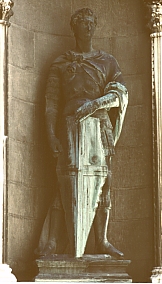 |
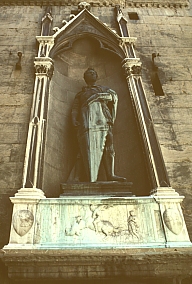 |
| |
|
| The relief at the base of the tabernacle depicts St. George slaying the dragon. It is noteworthy because of its new relief style, the so-called relievo schiacciato, misleadingly translated as "flattened relief." Instead of a flat relief background out of which figures and details emerge, here deep space is depicted through optical qualities in the carving which emphasize light and shadow. This kind of pictorial relief gives a sense of atmospheric perspective and the illusion of depth. |
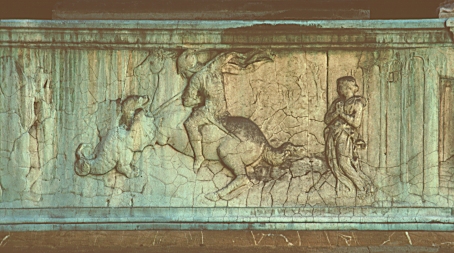 |
| |
|
St. George killing the Dragon; the Maiden wrings her hands in fearThe architecture behind the maiden is probably not in correct geometrical perspective. Donatello does, however, convey a sense of distance nonetheless. Note, for example, the low relief trees in the background. |
 |
 |
| |
|
| These two pictures were taken in 2005 whereas the others above were shot in the 1980s. |
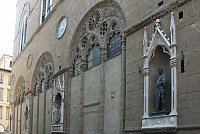 |
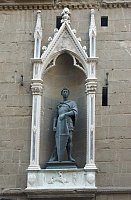 |


 Click here to return to Introduction on Orsanmichele.
Click here to return to Introduction on Orsanmichele.
 Click here to return to index of art historical sites.
Click here to return to index of art historical sites.
 Click here to return to index of artists and architects.
Click here to return to index of artists and architects.
 Click here to return to chronological index.
Click here to return to chronological index.
